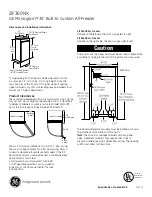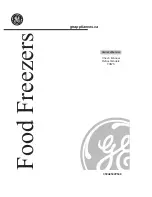
- 8 -
INSTALLATION INSTRUCTIONS
(cont’d)
PIPING
Refrigerant line sizes are important and may not be the
same size as the coil connections (depends on the
length of run). If in doubt, consult “Recommended
refrigerant line sizes” charts.
WIRING
Wire system in accordance with governing standards
and local codes. Enclosed typical wiring diagrams are
for reference only. Refer to unit data plate for operating
current, minimum ampacity and maximum fuse sizing
for fan motors.
NOTE:
Electrical wiring is to be sized in accordance
with minimum ampacity rating.
For ease of identifying the proper wiring terminals, unit
wiring is colour coded and terminal block connections
are identified. When
fan delay thermostats
(combina-
tion fan delay and defrost termination) are installed, on
start-up, the fans do not operate until the coil tempera-
ture is reduced to approximately 20 °F
(-6.7 °C)
. It is
normal for the fans to cycle a few times until the room
temperature is brought down. At higher evaporating
temperatures this control is of an adjustable type, and
proper adjustment is required.
The
defrost termination control
is adjustable and may
be set at a minimum of 40 °F
(4.4 °C)
(fully CW) to a
maximum of 75 °F
(23.8 °C)
(fully CCW). Normal setting
is 55 °F
(12.8 °C)
. This can be increased if the defrost
heaters are terminated too soon (frost still left) or if
terminated too long (steaming of coil). Time clock
should be set for a fail-safe termination of approximately
45 minutes.
A hinged end panel provides quick access to the electri-
cal compartment.
SYSTEM CHECK
Before Start-Up:
1. All wiring should be in accordance with local codes.
2. All refrigerant lines should be properly sized.
3. Electric defrost systems should include a liquid line
solenoid valve.
4. Thorough evacuation and dehydration has been
performed.
5. The suction, discharge and receiver service valves
must be open.
6. The system should include a liquid line drier moisture
indicator and suction filter.
7. Pour enough water into the drain pan to allow a good
check on drainage and seal the trap.
After Start-Up:
1. If necessary, temporarily by-pass fan delay control to
run fans until room temp is lowered. (Run jumper wire
from terminal N to F on circuit terminal block).
2. Check the compressor oil level to ensure the correct
oil charge.
3. Be sure that the expansion valve is properly set to
provide the correct amount of superheat (should be
around 70% of operating T.D.)
4. Heavy moisture loads are usually encountered when
starting the system for the first time. If the coil
temperature is below freezing, this will cause a
rapid build-up of frost on the coil. During the initial pull
down, frost build-up should be watched and defrosted
manually as required.
5. Check for proper evaporator fan blade rotation.
MAINTENANCE
1. Periodic checking and cleaning of the coil surface
when necessary should be done, using a whisk or
brush. Drain pans are hinged to provide convenient
access to the inside coil surface (except hot gas loop
pans).
2. Ensure coil and pan does not have any excessive ice
build-up from improper defrost operation. Any build-up
of ice can cause fins and refrigerant tubes to be
crushed. When replacing heater elements, first remove
heater slot covers and heater clips
3. Motors are permanently lubricated type and require
no further lubrication.






























